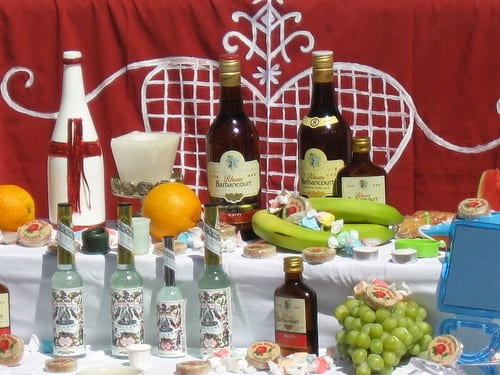The Roots of Haitian Vodou
Learn more about: Vodun to Vodou
Haitian Vodou, although comprised of a multitude of religions originating from Africa, is primarily originated from Vodun, a religion practiced in Benin.
Vodou is a creolized religion that originated in the West Indies of Haiti during the seventeenth century. The foundations of this practice evolved from Tribal religions in West Africa. The word ‘Voodoo’ derives from the word ‘vodu’ in the Fon language of Dahomey, which means ‘spirit’, ‘god’. Vodou was brought to Haiti by slaves being captured from the Dahomey Kingdom. The Dahomey Kingdom is located near present day Nigeria. During the seventeenth century this area was very isolated which allowed the practice to rapidly evolve and develop. The population consisted of different tribes and the enslaved Africans. These tribes shared several beliefs such as the worship of the spirits of family ancestors and the belief that followers were possessed by immortal spirits. They also used singing, drumming and dancing in religious rituals. Once living in Haiti, the slaves created a new religion based on their shared beliefs and those of the tribe’s. The practice of these traditions allowed slaves to feel free and get passed their hardships.
As slaves migrated they continued to practice Vodou. White slave owners prohibited the native religions forcing slaves to worship in hiding. Slave owners threatened slaves and baptized them all as Catholic, in hopes of stopping the Vodou religion. Although the slaves still practiced Vodou they adapted to some Catholic traditions. These traditions include hymns, prayers, and rituals, which are still used in present day Vodou.
“Ring, Jennifer. “Haitian Vodou Flags Tell Tales of Revolution and Independence at Tampa Museum of Art.” Creative Loafing: Tampa Bay, 2019, www.cltampa.com/arts-entertainment/visual-art/article/21086990/haitian-vodou-flags-tell-tales-of-revolution-and-independence-at-tampa-museum-of-art.
“The Origin of Voodoo.” From Chicago to New Orleans an Back in the Internet, www.univie.ac.at/Anglistik/webprojects/LiveMiss/Voodoo/chap1.htm.
Key Terms Defined
-
-
- Lwa: An ancestral spirit with the ability to communicate to a higher god with which humans are unable to directly contact.
- Papa Legba: A guardian figure and Lwa, often portrayed as older man with a cane. Papa Legba is a Lwa known to be the gatekeeper between worlds, who controls crossroads and destiny.
- Manman: Haitian Creole for mother.
- Une belle vie: Translates to ‘a good life’ from Haitian French.
- Altar: A place with which the living is able to contact the divine and worship their Lwa.
-
Deterville, Duane. “Drawing Down Spirits: Sacred Ground Markings of Vodou in San Francisco.” San Francisco Museum of Modern Art, 2009, openspace.sfmoma.org/2009/09/drawing-down-spirits-sacred-ground-markings-of-vodou-in-san-francisco/.
Platoff, Anne M. Drapo. “Vodou: Sacred Standards of Haitian Vodou.” North American Vexillological Association, 2015, nava.org/digital-library/frq/FRQ_007_2015.pdf .
Vodou to Voodoo in the United States
Voodoo was brought to Louisiana, specifically in New Orleans’ French Quarter, during the colonial period by enslaved sub-Saharan Africans from West Africa and Haitian slaves. The practice of making and wearing charms and amulets for protection, healing, and harming others were important aspects to early Louisiana Voodoo. Marie Laveau was a key figure in the history of Louisiana Voodoo, feared and respected by white men even during a time of slavery. She was a dedicated Catholic and practitioner of Voodoo, protecting and healing many people of color in New Orleans during her life in the 1800s.
As Voodoo spread, the diversification of practices and cultural appropriation did as well. The practices of Voodoo vary by city and household across the country.
“N.Y./Region: Brooklyn Voodoo.” YouTube, The New York Times, 2011, www.youtube.com/watch?v=nFUW0ALTMnY .
Reckdahl, Katy. “The True History and Faith Behind Voodoo.” New Orleans French Quarter, www.frenchquarter.com/true-history-faith-behind-voodoo/.
Misconceptions of Vodou
Learn more about: The Misunderstanding and Importance of Vodou in Haiti
There are plenty of misconceptions about Vodou, most of which come from television and films such as Live and Let Die (1973), The Serpent and the Rainbow (1988), and Child’s Play (1988). Many consider Vodou to be an organized religion when in reality it is more complex and is mostly centered on healing. Another misconception is that Vodou comes from Africa. However, it derives from practices in several parts of Africa that were combined with catholic rituals, due to slaves adopting their owners’ religion, as well as new practices in the Caribbean. Vodou believes in one God. However, because that one specific God is too far away for them, practioners call upon spirits or lwa, for aid and guidance. These lwa are divided into different “houses.” Some houses have stronger spirits than others. A popular misconception is that all Vodou is evil. Instead, in Vodou energy is amoral and can be used toward different ends. Summoning the lwa isn’t a dark ritual, but rather a ceremony of connection and togetherness. Song and rhythm is often involved to strengthen the spirits.
Griffiths, Vanessa, et al. “Misconceptions of Haitian Vodou.” Making History Matter, 2 Feb. 2015, makinghistorymatter.ca/2012/12/21/misconceptions-of-haitian-vodou/.
Meehan, Mary. “Misconceptions about Voodoo Abound.” Kentucky, Lexington Herald Leader, 4 Dec. 2010, www.kentucky.com/living/religion/article44066973.html.
Cultural Appropriation
Learn more about: Cultural Appropriation of Vodou
In the United States, Vodou has almost been normalized to culturally appropriate the religion. Examples of this can be found in retail, cinema, and stereotypes across the country:
-
-
- Watchover Voodoo is a popular brand that has sold their keychains in major stores in the US and UK, including Walmart.
- The Voodoo Music + Arts Experience is a music festival in New Orleans, LA, that consists of many white concert goers dressing up in costumes that culturally appropriate Vodou and Mexican culture, among others. The performers include top Billboard artists such as Post Malone.
-
“Experience Voodoo.” Voodoo Music + Arts Experience, www.voodoofestival.com/experience/.
-
-
- Cultural appropriation can even be found at the grocery store. The brand Utz created a flavor of chips called Voodoo.
- Even children’s cartoons such as Scooby Doo have appropriated the religion, as shown below:
-
“Scooby Doo Where Are You! The Gang Find Voodoo Dolls of Themselves and Daphne Disappears.”YouTube, WBTV Jeepers, 5 Dec. 2018, www.youtube.com/watch?v=UknHa3NQ9YA.
Olivia Bowman, Angel Townsend, Victoria DeSantis, & Aeon Scott, 2019





